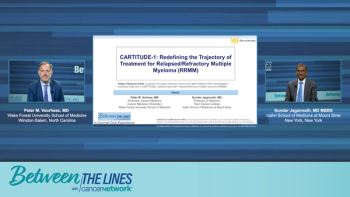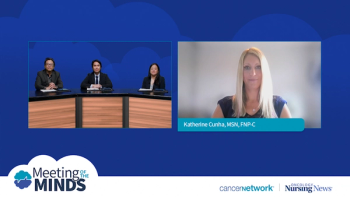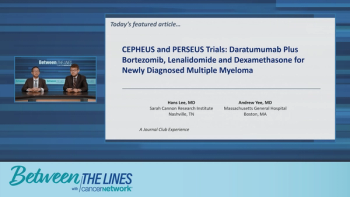
Panelists discuss how the evolution of FDA approvals for multiple myeloma therapies reflects rapid innovation and increasing effectiveness, particularly with cell-based treatments.

Your AI-Trained Oncology Knowledge Connection!


Panelists discuss how the evolution of FDA approvals for multiple myeloma therapies reflects rapid innovation and increasing effectiveness, particularly with cell-based treatments.

Panelists discuss how advancements in treatment options, including chimeric antigen receptor (CAR) T-cell therapy, bispecific antibodies, and antibody-drug conjugates, are shaping the current multiple myeloma landscape.

Panelists discuss how the extended median follow-up data from the MonumenTAL-1 trial demonstrate that Q2 weekly dosing of talquetamab shows superior progression-free survival (11.2 vs 7.5 months), duration of response (19.5 vs 7.5 months), and overall survival compared with weekly dosing, with particularly encouraging efficacy in high-risk cytogenetics and older patients while maintaining a manageable safety profile.

Panelists discuss how bispecific antibodies have evolved in relapsed/refractory myeloma treatment, highlighting recent data developments, the importance of NCCN guideline updates, including prophylactic tocilizumab recommendations, and strategies for improving toxicity management and community practice implementation.

Panelists discuss how cytokine release syndrome can be managed through early intervention with tocilizumab and steroids, and emphasize the importance of patient and staff education for safe outpatient administration.
![“If you have a [patient in the] fourth or fifth line, [JNJ-5322] could be a valid drug of choice,” said Rakesh Popat, BSc, MBBS, MRCP, FRCPath, PhD.](https://cdn.sanity.io/images/0vv8moc6/cancernetwork/267879fc15a40ec8d3ed04d8ee9c1f044b49ee89-2990x1692.png?w=350&fit=crop&auto=format)
“If you have a [patient in the] fourth or fifth line, [JNJ-5322] could be a valid drug of choice,” said Rakesh Popat, MBBS, PhD, MRCP, FRCPath.

Panelists discuss how talquetamab shows a more favorable safety profile with significantly lower high-grade infection rates compared with B-cell maturation antigen (BCMA)–directed bispecifics, although a new cerebellar toxicity signal requires monitoring.

Earlier treatment with daratumumab may be better tolerated for patients with pretreated MRD-negative multiple myeloma.

The trispecific antibody JNJ-5322 demonstrated superior efficacy vs approved agents in multiple myeloma in results shared at the EHA 2025 Congress.

Despite CD19 CAR T-cell therapy exhibiting efficacy in patients with relapsed/refractory large B-cell lymphoma, less than half achieve long-term remission.

Panelists discuss how the treatment landscape for EGFR-mutant non–small cell lung cancer has evolved to include 3 viable frontline options (osimertinib alone, osimertinib plus chemotherapy, and amivantamab plus lazertinib), with treatment selection based on patient characteristics, preferences, and physician judgment rather than a strict algorithmic approach.

Panelists discuss how a 46-year-old graphic designer with stage IV EGFR-mutant non–small cell lung cancer and brain metastases was successfully treated with amivantamab plus lazertinib after weighing multiple frontline treatment options.

Panelists discuss long-term results from a phase 3 trial comparing luspatercept and epoetin alfa in lower-risk MDS, highlighting luspatercept’s superior efficacy in achieving sustained transfusion independence and the need for further research on earlier intervention strategies.

Panelists discuss the results of the phase 3 EPO-PRETAR trial in a dynamic, debate-style forum on lower-risk myelodysplastic syndromes, weighing the benefits of early vs late erythropoiesis-stimulating agent initiation while highlighting the need for more patient-centered outcome measures.

Panelists discussed the persistent risk of interstitial lung disease with trastuzumab deruxtecan, emphasizing the need for early detection through routine imaging, rapid intervention to prevent severe toxicity, and cautious retreatment in select cases where interstitial lung disease was mild and well managed.

“Dendritic cell vaccines, CAR T-cell therapy, and things of that nature are holding some promise,” said Andrew Brenner, MD, PhD.

Panelists discussed how DESTINY-Breast03 firmly established trastuzumab deruxtecan (T-DXd) as the second-line standard in HER2-positive metastatic breast cancer, while early DESTINY-Breast09 data suggest that T-DXd combined with pertuzumab may challenge the CLEOPATRA regimen in the frontline setting, though questions remain about global applicability.

Andrew Brenner, MD, PhD, stated that rhenium obisbemeda elicited similar results in leptomeningeal disease as it did in recurrent glioma.

Panelists discuss how successful ADC administration requires robust coordination between oncology and eye care teams through same-day appointments and shared medical records at academic centers, while emphasizing the need for partnerships with local eye care providers, standardized protocols, and expanded provider education to ensure safe delivery in community settings as more ADCs enter clinical use.

Panelists discuss updated American Society of Clinical Oncology (ASCO) data showing that 4-drug regimens significantly improve outcomes even in patients with transplant-ineligible multiple myeloma, with real-world dose modifications enabling broader use while maintaining efficacy and tolerability.

Panelists discuss how CAR T monitoring requirements have evolved from initially conservative inpatient approaches to more flexible outpatient strategies, exploring ways to reduce the burden of mandatory 30-plus-day proximity requirements while maintaining patient safety and improving treatment accessibility.

Panelists discuss updated American Society of Clinical Oncology (ASCO) data showing that adding a CD38 monoclonal antibody to frontline triplet therapy improves minimal residual disease (MRD) negativity and progression-free survival in standard and intermediate-risk multiple myeloma, while reinforcing the need for tailored strategies in high-risk patients.

Managing Ocular Side Effects of ADCs ADC therapy often leads to ocular side effects, requiring proactive management. A typical patient scenario involved mild vision issues that escalated to moderate keratopathy. Regular ophthalmologic monitoring and timely intervention allowed continuation of treatment at a reduced dose while maintaining visual function. Standard care includes a baseline eye exam, ongoing optometry visits, steroid and lubricating drops, and close coordination between oncology and eye care. Dose holds and reductions based on severity are effective in reversing toxicity while maintaining disease control. This case illustrates that with proper planning, patients can stay on effective therapy despite complications. Collaborative care between oncologists and eye specialists ensures that ocular side effects are addressed early, allowing treatment continuity and preserving quality of life.

Panelists discuss how CAR T cell therapy has transformed lymphoma treatment with multiple FDA-approved products showing 70% to 80% overall response rates and 50% to 60% complete response rates across different B-cell malignancies, while emphasizing the importance of comparing clinical trial data with real-world evidence to understand true efficacy and safety profiles.

Patients with recurrent glioblastoma who had an absorbed dose of greater than 100 Gy with rhenium obisbemeda had a median overall survival of 17 months.

According to Andrew Brenner, MD, PhD, rhenium obisbemeda can be detected via SPECT imaging and aids in the care of patients with glioblastoma.

Current findings from the phase 1/2 CaDAnCe-101 trial show no predictive factors of improved responses with BGB-16673 in patients with CLL or SLL.

Breast oncologist Jade E. Jones, MD, says she tries to send patients with HR-positive BRCA-mutant TNBC to clinical trials that use PARP inhibitors.

According to Benjamin Golas, MD, PIPAC is emerging as minimally invasive laparoscopic approach for patients with peritoneal carcinomatosis.

Panelists discuss how talquetamab demonstrates remarkable efficacy in patients previously exposed to T-cell redirecting (TCR) therapies, with response rates and duration comparable to treatment-naive patients.